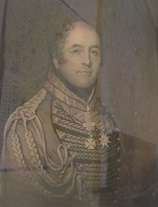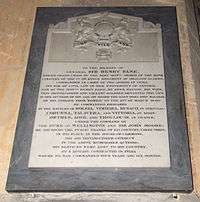Henry Fane (British Army officer)
| Sir Henry Fane | |
|---|---|
 Sir Henry Fane | |
| Born | 26 November 1778 |
| Died | 24 March 1840 (aged 61) |
| Allegiance |
|
| Service/branch |
|
| Rank | General |
| Commands held | Indian Army |
| Battles/wars | Peninsular War |
| Awards | Knight Grand Cross of the Order of the Bath |


General Sir Henry Fane GCB (26 November 1778 – 24 March 1840) commanded brigades under Arthur Wellesley, 1st Duke of Wellington during several battles during the Peninsular War, and served both as a member of Parliament and Commander-in-Chief of India.
Origins
He was the eldest son of Hon. Henry Fane (d.1802), of Fulbeck Hall, Lincolnshire, younger son of Thomas Fane, 8th Earl of Westmorland.
Military career
Fane joined the 6th Dragoon Guards as a cornet in 1792 and served as aide-de-camp to the Lord Lieutenant of Ireland, John Fane, before obtaining a Lieutenancy in the 55th Regiment of Foot. He was promoted to Captain-lieutenant in the 4th Dragoons in 1795; to Major the following year and to Lieutenant-colonel in 1797, subsequently serving throughout the rebellion that year. On 1 January 1805 following his removal to the Lieutenant-colonency of the 1st King's Dragoon Guards, he was appointed aide-de-camp to King George III, which made him a Colonel in the army.[1]
Peninsular War
As a brigadier general, Fane commanded a brigade in Wellesley's army at the Battle of Vimeiro in August 1808. His brigade, which included the 1/50th West Kent, 5/60th Royal Americans, and four companies of the 2/95th Rifles Foot, took a key part in repelling the French frontal attacks on Vimeiro village.[2]
During Sir John Moore's expedition in Spain, Fane commanded the 2nd Brigade (1/38th 1st Staffordshire, 1/79th Cameron Highlanders, 1/82nd Prince of Wales Volunteers Foot) in Alexander Mackenzie Fraser's 3rd Division. The 3rd Division was present but not engaged at the Battle of Corunna in January 1809.[3]
Fane missed the Second Battle of Porto, since his heavy cavalry brigade (3rd Prince of Wales Dragoon Guards, 4th Queen's Own Dragoons) was guarding the Portuguese frontier at Abrantes. While commanding the same brigade, he fought at the Battle of Talavera in July 1809.[4]
On 13 May 1810, Fane transferred to command a brigade that included the 13th Light Dragoons and four Portuguese mounted regiments. He was present at the Battle of Bussaco, while attached to Rowland Hill's 2nd Division. He went home ill before the end of 1810.[5]
On 24 April 1813, Fane was promoted to major general on the staff. Posted to command a brigade consisting of the 3rd Dragoon Guards and the 1st Royal Dragoons on 20 May,[6] he fought at the Battle of Vitoria in June. In that battle, his cavalry fought with Hill's Right Column, being lightly engaged.[7]
During late 1813, Wellington sent most of his cavalry to the rear since they were almost useless in the rough terrain of the Pyrenees. In January 1814, Fane transferred to lead a brigade that included the 13th and 14th Light Dragoons. There is evidence that Fane effectively commanded both his old and new brigades in the final battles in southern France.[8] Wellington called his cavalry forward in February, his light cavalry arriving first.[9] Fane's brigade fought at the Battle of Orthez and was present at the Battle of Toulouse in April.[10]
For his Peninsula service, Fane was awarded the Army Gold Cross with one clasp for the battles of Vimeiro, Corunna, Talavera, Vitoria, and Orthez.
Later career
He was made a KCB in 1815 and a GCB in 1826. Fane served as MP for Lyme Regis in 1802–1816, MP for Sandwich in 1829–1830 and MP for Hastings in 1830–1831. He was named Commander-in-Chief of India in 1835. He died on 24 March 1840.[11]
Marriage and progeny
Fane formed a 'strong attachment' to Isabella, daughter of Hamilton Gorges, and wife since 1791 of Edward Cooke,[12] described in his will as "of Avon" (i.e. Avon Tyrrell, Sopley, Hampshire) and from 1801 lived together as man and wife, they had six children, of them three survived infancy:[13]
- Col. Henry Fane (1802-1836), life tenant of Fulbeck Hall, Lincolnshire, under the will of his father.[14] Started his military career as Capt. 4th Regiment, Dragoon Guards. Three sons surviving in 1880.[15]
- Rev. Arthur Fane (1809–1872), appointed rector of Fulbeck by his father. Educated at Exeter College, Oxford. Married Lucy Bennett, daughter and heiress of J. Bennett of Peyt House, Wiltshire, and Boyton Manor, Codford, Wilts. Six children surviving in 1880.[16] Appointed Prebendary of Salisbury. Served as domestic chaplain to his cousin the Earl of Westmorland. His grandson Major Henry Nevile Fane (1883–1947), Coldstream Guards (son of his third son Sir Edmund Douglas Veitch Fane (1837–1900) KCMG) married Hon. Harriet Trefusis (d.1958), daughter and senior co-heiress of Charles Hepburn-Stuart-Forbes-Trefusis, 21st Baron Clinton(d.1957). Major Henry Fane's grandson (by his son Capt. Charles Nevile Fane) was Gerard Nevile Mark Fane, who assumed the additional surname of Trefusis following the death of his grandmother Harriet, and became 22nd Baron Clinton in 1965, having claimed the termination of the 1957 abeyance of that title.
- Isabella Fane (1804-1880), spinster.[17] Her letters from India, while acting as her father's hostess between 1835-1838, are described as "corrective to the notion that all Englishwomen in India were of the straightlaced memsahib type - snobbish, imperious and racially prejudiced".[18]
References
- Glover, Michael. The Peninsular War 1807–1814. London: Penguin, 2001. ISBN 0-14-139041-7
- Oman, Charles. Wellington's Army, 1809–1814. London: Greenhill, (1913) 1993. ISBN 0-947898-41-7
- Philippart, John (1820). The Royal Military Calendar or Army Service and Commission Book. III.
- Smith, Digby. The Napoleonic Wars Data Book. London: Greenhill, 1993. ISBN 1-85367-276-9
- Zimmermann, Dick. "Battle of Vimeiro," Wargamer's Digest magazine, vol 10, no 12, October 1983.
Footnotes
- ↑ Philippart 1820, p. 25.
- ↑ Zimmermann, p 33
- ↑ Smith, p 278
- ↑ Glover, p 373-4
- ↑ Oman, p 346
- ↑ Oman, p 367
- ↑ Smith, p 430
- ↑ Oman, p 372
- ↑ Glover, p 313
- ↑ Smith, p 518
- ↑ Urban, Sylvanus: The Gentleman's Magazine, vol 4, p 426. William Pickering
- ↑ Source: The History of Parliament - Sir Henry Fane (1788-1840)
- ↑ Source: his will, copy held by Lincolnshire Archives, 1 FANE 4/8. He is stated erroneously in some otherwise reputable biographies to have died without progeny
- ↑ Per his will, Lincolnshire Archives, 1 FANE 5/37/2
- ↑ Per will of sister Isabella Fane (d.1880)
- ↑ Per will of sister Isabella Fane (d.1880)
- ↑ Per her will, Lincolnshire Archives, 1 FANE 5/26/1
- ↑ Miss Fane in India, edited by John Pemble, Allan Sutton Publishing Ltd 1985, p.4.
External links
- Hansard 1803–2005: contributions in Parliament by Henry Fane
| Parliament of the United Kingdom | ||
|---|---|---|
| Preceded by Hon. Henry Fane Hon. Thomas Fane |
Member of Parliament for Lyme Regis 1802–1818 With: Hon. Thomas Fane 1802–1806 Lord Burghersh 1806–1816 John Thomas Fane 1816–1818 |
Succeeded by John Thomas Fane Vere Fane |
| Preceded by Joseph Marryatt Sir Edward Owen |
Member of Parliament for Sandwich 1829–1830 With: Joseph Marryatt |
Succeeded by Joseph Marryatt Samuel Grove Price |
| Preceded by Evelyn Denison Joseph Planta |
Member of Parliament for Hastings 1830–1831 With: Joseph Planta |
Succeeded by John Ashley Warre Frederick North |
| Military offices | ||
| Preceded by Sir William Payne, Bt |
Colonel of the 23rd Regiment of (Light) Dragoons 1807–1814 |
Succeeded by Sir George Anson |
| Preceded by Miles Staveley |
Colonel of the 4th (Royal Irish) Dragoon Guards 1814–1827 | |
| Preceded by William Cartwright |
Colonel of the 1st (The King's) Dragoon Guards 1827–1840 |
Succeeded by Sir William Lumley |
| Preceded by Sir Herbert Taylor |
Surveyor-General of the Ordnance 1829–1831 |
Succeeded by William Leader Maberly |
| Preceded by Sir James Watson |
Commander-in-Chief, India 1835–1839 |
Succeeded by Sir Jasper Nicolls |
